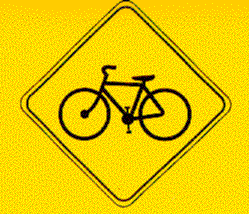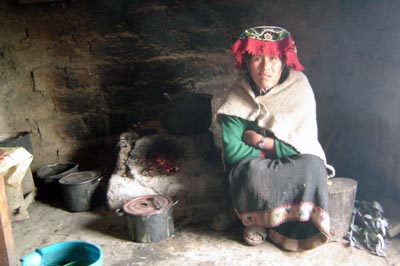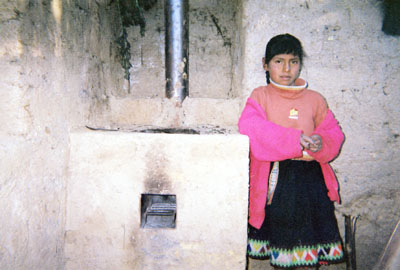
Where are Ron and Ellen?
Latin America: 10 November 2008 - 3 March 2009
Vidas Mejoradas photos, Sipascancha, Peru: left - open fire pit cooking; right - newly-constructed cookstove with chimney
Travel plans, November 2008 - March 2009
On Monday 10 November 2008 We fly from Washington DC to Lima, Peru. We plan to spend one night in Lima, then head south by bus. We will go first to Chincha, where Ron hopes to locate the family he spent time with in 1971 and who visited us in Afton in ~1980.From Chincha we'll continue south to Nazca, to see the Nazca Lines. Our Lonely Planet guide book says, "Spread across an incredible 500 sq km of arid, rock-strewn plain, the Nazca Lines remain one of the world's great archaeological mysteries. Consisting of over 800 straight lines, 300 geometric figures (geoglyphs), and, concentrated in relatively small area, some 70 spectacular animal and plant drawings (biomorphs), the lines are almost imperceptible at ground level. It's only when viewed from above [i.e. from an airplane] that they form their striking network of enormous stylized figures and channels, many of which radiate from a central axis."
From Nazca we'll continue by bus to Arequipa, an old city, Peru's second-largest. It is at 2350m (7708 ft), a good place to acclimate before going on to higher altitudes -- and friends tell us they make wonderful chocolate there. Next stop will be Puno, on Lake Titicaca, at 3830m (12,565 ft) the world's highest navigable lake and also South America's largest. Then on to Cusco (3326m or 10,912 ft).
We plan to arrive in Cusco on approximately 24 November, 2 weeks after our arrival in Peru. We will spend 3 weeks in Cusco and the surrounding area (which includes Machu Picchu and other Incan ruins).
Ellen flies back home on Monday 15 December. Ron will head for Bolivia and Paraguay, then go on to Brazil, where he plans to spend most of his time before returning from Sao Paulo on 3 March 2009.
As usual, we'll send travel accounts along the way, and Ellen will post the accounts and the photos to our Web page when she returns. (And yes, it's true -- we aren't taking our bikes on this trip!)
Three weeks in Cusco? Yes, we do travel slowly, but why three weeks in one place? Our son Steven and his girlfriend Laurie will be returning to Peru on 17 November to spend 4 months based in Cusco working on their Vidas Mejoradas project. Steven and Laurie, a nurse, along with their Peruvian colleague, Pavela, work together as Vidas Mejoradas (Better Lives) in small poor communities in the high Andes. They go to upwards of 14,000 feet to rarely accessed villages where Quechua-speaking people live in extreme temperatures in sparsely furnished adobe shacks. All are subsistence farmers who earn less than $5 per month. Few have extras like vehicles, medical care, or even a third set of clothes. In some of these villages, even access to chlorinated water has only happened recently. People cook over an open fire pit with no chimney against a wall covered in soot. Villagers, particularly children, often have respiratory problems that persist throughout the year and progress to bronchitis and pneumonia. Although many factors contribute to poor family health, Vidas Mejoradas has chosen to focus on one of the simplest and easiest ways to help -- introducing a basic cooking stove with a chimney that burns wood more efficiently and removes the smoke from the living space.
A hallmark of the work of Vidas Mejoradas is that they do not simply give the stoves away. Families who choose to participate become invested in their stove by doing their part in the construction. They sign contracts to formalize the process. Each family agrees to a survey that evaluates their basic respiratory health, cooking and fuel habits. They make the 40 adobe bricks required for the stove body, collect ash for combustion chamber insulation, and pay 20 soles or approximately $6. The money from villagers goes toward a project that benefits the community in perpetuity, such as tree nurseries or animal-raising. Steven, Laurie, and Pavela contract with local businesses in the nearest city to make the combustion chambers, chimneys and grates, local trucks transport the materials to the villages, and local people are employed to visit even the most remote of homes to make sure the stove is built properly.
Vidas Mejoradas is not part of a larger supporting organization or foundation. In 2007 Steven and Laurie had a small grant from the Catholic Medical Missions Board that covered their air fare, but they raised the money themselves for the full costs of the stoves and their own expenses. In 2008, they have no grant support, so are funding all expenses from the money they personally have saved and are raising.
During March-June of 2007, Steven, Laurie, and Pavela worked in Sipascancha, a village northeast of Cusco where Laurie had done basic health outreach and education in 2003-2004. After discussions with villagers about the stoves, their benefits, and the project participation process, Laurie gathered basic medical information from families participating in the stove project -- blood oxygen levels, lung capacity, and simple medical history focusing on respiratory health. While villagers made their adobe bricks and collected ash to insulate the combustion chamber, the metal parts were fabricated in Cusco, then trucked to the village 2.5 hours away. After instruction and demonstrations on proper construction, each participating family built their own stove.
In November 2008, Laurie, Steven, and Pavela will repeat the collection of basic medical information with the Sipascancha families who have been using stoves for a year. They expect to document overall health improvements. Then they will begin working with villagers in Usi, 2.5 hours southeast of Cusco, to introduce the cooking stoves there.
The village school in Sipascancha and North Branch School in Afton (where Ellen is on the Board and our grandsons are students) are sister schools. The schools are similar in age range, and students in both schools are learning Spanish as their second language. Through Steven and Laurie, the students have exchanged drawings, and North Branch families gathered hundreds of pencils for the students there, who often must share one pencil between multiple children. Along with their drawings, North Branch students sent a DVD showing their school and classrooms, with students introducing themselves individually (in Spanish!). Although service is unreliable, there is electricity in Sipascancha, and the school has a computer, so students there were able to watch the DVD. Laurie and Steven brought back for North Branch a short video of the students at the Sipascancha school. On this trip, Ellen will be carrying letters, drawings, and other things from North Branch to Sipascancha to continue the exchange begun in spring 2007. Children at both schools have been excited by the connection and by the glimpse of school life in a very different culture.
For those of you in Virginia, Nelson County potters Nan Rothwell and Kevin Crowe will be designating a portion of the proceeds from their joint fall show, Nelson Clay, to Vidas Mejoradas. They also hope to collect additional donations during the show to support this unique project. Nelson Clay will be held in Nanís and Kevinís studios on November 29 & 30 and December 6 & 7. So mark your calendars and go to the show to support our local potters and Vidas Mejoradas!
We have heard Steven's and Laurie's stories and seen their photos. Our three weeks in Cusco will give us a wonderful opportunity to see their work first-hand, to meet the people they are working with, and to visit Sipascancha and the school there. We're excited!
PS - A note on spelling: We asked Steven and Laurie about the correct spelling for the city that appears sometimes as Cusco and sometimes as Cuzco. Steven's response: "There is no consistent spelling in Quechua, as befits a language with almost no primary print sources. Simlar to Arabic in that respect. A lot of times we saw the "Q-apostrophe" letter Q' spelled with a double "C", as in CC. Very disorienting to see that at the beginning of words! So both are correct." Wikepedia tells us that in Quechua it is spelled Qusqu. We are going to try and be consistent with Cusco.
Final report on Vidas Mejoradas work in 2007 (link for downloading)
Life in Sipascancha Alta (link for downloading)
Sipascancha photos on Flickr
Back to the Latin America 2008-2009 index
Back to the Main Index
cfw.com
Questions? Send email to Ellen, ebouton 
operamail.com
While we're traveling, reach us at bikepacker 
Last updated: 6 October 2008

